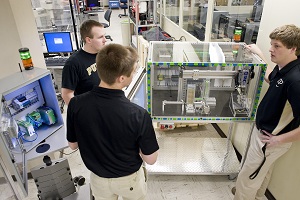ACADEMIA
Purdue automation team qualifies for international event
Representatives of a Purdue University automation team will travel to Germany in March as a finalist for the xplore New Automation Award 2012.
Purdue is one of two teams from the United States to be selected among the 28 finalists in six categories. The team, which has created an automated hammer assembly machine, will give its final presentation in Bad Pyrmont, Germany, on March 23.
Winners of each category will be invited back to Germany in April to demonstrate the project at the Hanover Fair, an industrial automation show.{hwdvs-player}id=408|height=240|width=320|tpl=playeronly{/hwdvs-player}
The Purdue team, consisting of seven seniors studying manufacturing engineering technology, is competing in the "factory" category against five entries. Purdue's project is a much-improved version of an automated hammer assembly machine completed two years ago for a different trade show style event, according to Brad Harriger, professor of mechanical engineering and technology and team adviser.
The machine allows customers to choose from three colors of hammerheads and three colors of handles by using a simple touch screen computer program. Pneumatic components then place the selected parts into an area for assembly. The process takes 20-30 seconds.
"Our success rate is just above 99 percent with this machine, whereas last time we were at about 50-60 percent with the old machine," said senior Jason Wintz from Batesville, Ind., a member of both the current team and the original hammer assembly team.
Wireless components were added to the machine, one of the biggest changes from the project created two years ago.
"What makes this unique is the controller for the machine can actually be wheeled across the room and still be communicating with the input and output devices, such that it still produces and makes the product," said Harriger.
The team submitted a video application in June and once selected to participate in the contest, received $4,000 in control equipment from event sponsor Phoenix Contact. A pneumatic cylinder and an automated valve pack were donated to the team by SMC Corp.
In August, the team started using a CAD-modeling computer program to design the machine.
"It allowed us to build the machine on the computer virtually and check for any interferences," Wintz said. "From there we were able to start building individual components. Once everything was built, we started the programming."
All aspects of the contest - design, manufacturing, programming and testing - were completed by students.
"With this machine we tried to make everything look real clean and tuck the wires as much as we could running through the bottom and up through the back," said team member Ryan Streu of Two Rivers, Wisc.
"We tried to go with more of a trade show look," added team member Mike Harrington of Riverside, Ill.
Competing in xplore New Automation 2012 will benefit team members once they pursue jobs upon graduation.
"You could see this same type of machine assembling parts in an industry somewhere," Harriger said. "That's where our students go to integrate these technologies. If they can go in and describe how they went about solving a problem, it's a big asset. It's really big feather in their cap to say, 'I've taken this practical knowledge and turned it into something useful, practical and real.'"
Other team members include seniors David Burroughs, Aaron Burns, Derek Andrews and George Hinote.

